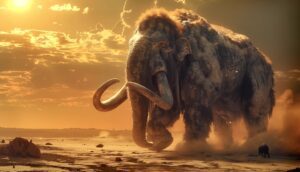
AMERICAN ASSOCIATION FOR THE ADVANCEMENT OF SCIENCE (AAAS)—Proboscidean species – animals including modern elephants and extinct wooly mammoths – experienced a five-fold increase in extinction rates when early humans appeared, according to a new model-based study* involving fossil data. The work also ties the subsequent rise of modern Homo sapiens with a 17-fold increase in proboscidean extinction rates. Fossil records hold clues about how speciation and extinction have influenced ecosystem turnover throughout millennia. Yet, these impacts have proven hard to model. Most attempts to do so have only incorporated single predictors, such as one environmental change or the acquisition of a single trait, which does not reflect the multi-faceted nature of evolution. Here, Torsten Hauffe and colleagues present a new neural network-based statistical approach that can use fossil records to yield a more nuanced portrayal of species diversification. They fed the model pre-existing information about 2,118 fossils belonging to 175 proboscidean species that lived from 35 million years ago to 10,000 years ago. The neural network assessed 17 environmental and morphological factors, such as tusk characteristics and body size, and incorporated data about relevant paleotemperatures and paleo-environments. It also considered human interactions, including the arrival of early humans in the Pleistocene roughly 1.8 million years ago and the emergence of modern humans around 129,000 years ago. The findings pointed towards dietary adaptation and flexibility as a driver of speciation, particularly at the end of the Neogene a little under 3 million years ago. Most notably, results showed that proboscidean extinctions were very strongly affected by human activity and secondarily influenced by geographic distribution and dental morphologies. “We found that while humans exhibit the greatest impact in the past ca. 120,000 years, our results also point to a weaker yet significant influence of the human lineage at earlier times, thus supporting other studies suggesting a long-lasting detrimental anthropogenic effect on biodiversity,” the authors conclude.
________________________________

Many scientists suggest that the wooly mammoth went extinct at least in part due to overhunting by prehistoric humans. Kyraxys, Pixabay
________________________________
Article Source: AAAS news release.
*Trait-mediated speciation and human-driven extinctions in proboscideans revealed by unsupervised Bayesian neural networks, Science Advances, 24-Jul-2024. 10.1126/sciadv.adl2643
________________________________
Advertisement

EXPLORE THE ANCIENT ETRUSCANS IN PERSON!
Experience a unique, up-close-and-personal hike among ancient hilltop towns in central Italy. You will walk the sensational countryside of the regions of Umbria and Tuscany, soaking in important sites attesting to the advanced Etruscan civilization, forerunners of the ancient Romans; imposing architectural and cultural remains of Medieval Italy; local food and drink; and perhaps best of all — spectacular scenic views! Join us in this collaborative event for the trip of a lifetime!



